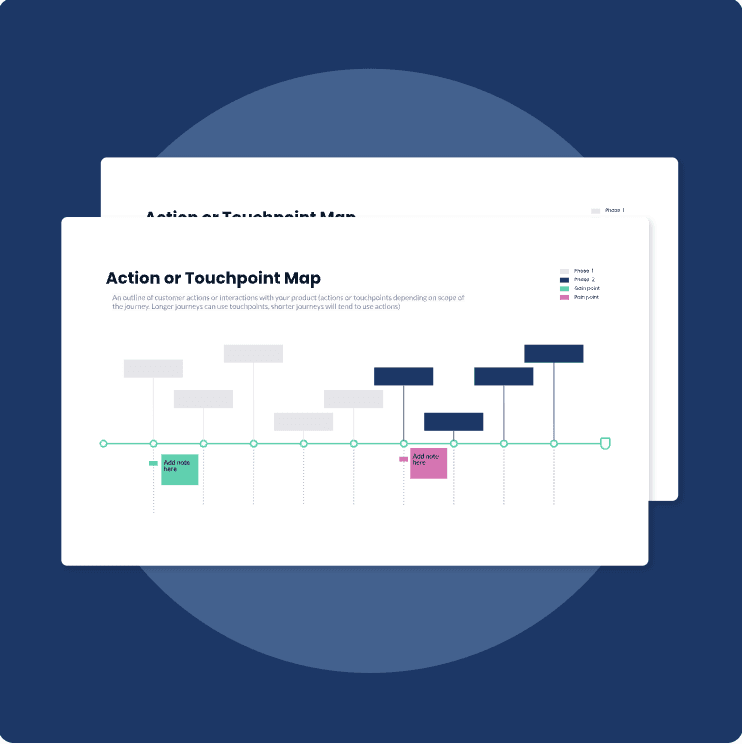Updated: July 9, 2025- 15 min read
The majority of your customers don’t adopt new tech right away. Some jump in early, but most wait and watch at first. And a few won’t budge unless they have to.
This simple pattern — how people adopt technology over time — has been studied for decades. It’s called the technology adoption curve, and it explains why even the best products don’t gain traction all at once.
In this piece, we’ll walk through what the curve is, the five types of adopters you’ll meet along the way, and how to use this framework to fuel product adoption and build smarter product strategies.
Product Roadmap Template
Download our easy-to-use template to help you create your Product Roadmap.
Get the Template
What Is the Technology Adoption Curve?
The technology adoption curve is a model that shows how different groups of people adopt new products or product innovations over time.
It was first introduced by sociologist Everett Rogers in 1962. It's still widely used by product teams to understand how users adopt technology and how product adoption spreads through a market.
The idea is simple: not everyone adopts new technology at the same time. People fall somewhere on a bell curve based on how quickly they’re willing to try something new.
How user adoption of new technology works
Imagine you’ve just launched a new productivity app.
At first, only a small group of curious users download. These may be the people who enjoy testing out new tools just for fun.
A few weeks later, a wave of early users joins in. Many of them share feedback and feature requests. Then momentum builds. Your user base grows, feedback turns into word of mouth, and eventually, even the most skeptical users give it a try because “everyone else is already using it.” The value has been proven!
That pattern, from early enthusiasts to late adopters, is what the technology adoption curve captures.
The 5 Stages of the Technology Adoption Curve

The technology adoption curve is divided into five distinct user groups, each with its own mindset, behavior, and expectations. These groups represent the journey from early enthusiasm to widespread use.
Understanding each stage helps product teams build better launch plans, messaging, and roadmaps tailored to how people actually adopt new technology.
1. Innovators: The risk-takers who try products first
Innovators are the first people to adopt new technology. They’re the ones who signed up for your beta before you even had a landing page. They love trying new products. Not because they need them, but because they’re curious, technically skilled, and genuinely excited about what's next.
Innovators make up a small percentage of your total market, according to Investopedia usually around 2.5%.
They’re critical for momentum in this innovation curve. Not because they’ll make great revenue, but because they’ll give you insight. Innovators are often the first to break things, offer honest feedback, and push your product in ways you didn’t expect.
This group doesn’t need social proof, polished UI, or a long list of case studies.
The innovators want:
Access before the crowd
A clear sense of what makes your product different
Opportunities to engage directly with your team
Innovators help stress-test your product when it’s still raw. They’re often forgiving of bugs, flexible with workarounds, and more likely to explore underdeveloped features.
But here’s the thing: just because they love your product doesn’t mean the rest of the market will.
One of the biggest mistakes product teams make is overvaluing this group’s excitement. What works for innovators often doesn't work for the next stage. So your goal here isn't to scale. It's to listen.
Use this phase to:
Validate core product value and technical feasibility
Identify unexpected use cases or edge behavior
Build relationships with early evangelists who may become power users or advocates later
The trick is to resist the temptation to over-engineer your product roadmap based on this group alone. They’re the spark, not the fire.
2. Early adopters: The first users who believe in your products
Early adopters come right after innovators, but they’re a different breed entirely.
They’re not just here to try new tech for fun. They’re here because they see potential. They’re visionary, strategic, and often looking for an edge, whether it’s in business, productivity, or personal life. They’re willing to take a calculated risk if the product clearly solves a real problem.
Early adopters usually make up about 13.5% of your market. They’re the ones who will write LinkedIn threads about your product, bring it into their teams, or start building processes around it — but only if they trust it.
Unlike innovators, they’re not impressed by novelty alone. They want to understand your product’s vision, the outcomes it can drive, and where it’s headed.
Here’s what early adopters could look for:
A clear and credible value proposition
Strong early UX (not perfect, but usable and coherent)
A public product roadmap that shows commitment to growth
Signals that your team understands their pain and is solving for it
They’re still tolerant of bugs and missing features, but only if the core product experience delivers real value. And they’re far more likely to leave if that value isn’t obvious.
Here’s what to focus on:
Sharpen your messaging so it speaks directly to use cases
Build basic onboarding flows that reduce time-to-value
Prioritize features that support early success stories
Start collecting proof: testimonials, case studies, retention rate
This is when product-market fit starts to feel within reach. But don’t confuse early traction with mass-market readiness.
3. Early majority: The cautious but crucial middle
The early majority is where real traction begins in new technology adoption curve. This group isn’t chasing product innovation. They’re looking for solutions that are proven, practical, and low-risk.
They make up about 34% of the market, making them the largest segment up to this point. This explains the bell curve of adoption.
These are the users who wait until a product has been validated by others — especially their peers. They care about what’s working now, not what might be great someday. Once they’re in, they tend to stick around longer than early adopters.
The early majority is driven by trust, predictability, and social proof. They want to know that:
The product is stable and supported
The other credible people or companies are already using it
The onboarding won’t feel like a chore
They’re not taking a big risk by switching
Unlike early adopters, who’ll tolerate friction in exchange for upside, the early majority needs things to just work. They’re not impressed by product vision — they’re won over by results.
How product teams should respond
This is the point where product-led companies need to shift gears. What worked for innovators and early adopters — rapid iteration, iterative direct feedback loops, scrappy onboarding — now needs to mature.
To serve the early majority well:
Invest in smoother, scalable onboarding experiences
Build out help docs, tutorials, and in-app guidance
Show credibility through logos, testimonials, and adoption stats
Prioritize performance, reliability, and support channels
The early majority won’t give you the benefit of the doubt. But if you meet their expectations, they’ll give you something even better: long-term retention, revenue stability, and market credibility.
This is where many products either scale or stall. Winning this group means your product is no longer just “new and interesting.” It’s becoming mainstream.
4. Late majority: The skeptics who need convincing
The late majority is cautious, skeptical, and slow to adopt in the software adoption curve. These users don’t trust hype, avoid risk, and only try new technology once it feels completely safe and standard. They're the ones who finally sign up after hearing about your product for the tenth time, from someone they know and trust.
Like the early majority, they also make up about 34% of the market. But their mindset is very different. They often feel pressure to adopt, not from curiosity or strategy, but because the world around them has already moved on. At this stage, they adopt out of necessity, not desire.
This group is looking for stability, familiarity, and cost-effectiveness. They need:
Simple, no-jargon messaging that makes it clear what the product does
Step-by-step onboarding with a minimal learning curve
Proof that the product is widely used and safe to bet on
Reassurance that support is available if they get stuck
They may also be sensitive to product pricing and expect discounts, bundles, or guarantees that make the switch feel less risky. By this point, your product should be mature. That means fewer surprises, more polish, and strong operational support.
Here’s what to prioritize:
Robust customer support and troubleshooting resources
Scalable onboarding and automation
Stability over innovation — refining what’s there, not launching big new bets
Sales enablement, partner programs, or integrations that reduce friction
This group is essential for capturing full market share. But they won’t evangelize. They’ll use your product quietly, cautiously, and often without much engagement. And that’s okay. As long as the experience is stable and predictable, they’ll stick around.
5. Laggards: The holdouts who adopt last (if ever)
Laggards are the final group on the technology adoption curve. They’re resistant to change, deeply skeptical of new tech, and often only adopt something when it becomes unavoidable. Think paper-based offices finally switching to email, or someone still not giving AI tools a try.
They make up roughly 16% of the market. While they’re the slowest group to adopt, they still matter — a lot! Especially in industries where full penetration is the goal (like government, healthcare, or legacy enterprise).
As Tricia Maia, the Head of Product at TED, said on the Product Podcast:
We need to create a differentiated experience. Otherwise, we might as well not have our own presence at this point.
Laggards don’t follow trends, and they don’t trust the market. Their adoption is driven by:
Necessity over desire
Social or professional pressure
Obsolescence of older solutions
Long-term cost savings that can’t be ignored
They tend to be late not because they’re uninformed, but because they’ve seen technologies come and go. They prefer to wait until change is absolutely required.
Laggards are not your core growth audience, but they can become important if your product is on its way to becoming infrastructure-level. Think of industries like telecom, utilities, or financial services.
To support this group, product teams should:
Provide simple, foolproof product experiences
Offer strong customer support (possibly even phone-based or in-person)
Ensure backward compatibility or migration paths from legacy systems
Focus on reliability, privacy, and long-term stability over feature sets
Why Adoption of New Technology Matters to Product Teams
Understanding where your users fall on the curve helps you:
Set realistic expectations for product adoption and product-led growth
Tailor brand messaging and onboarding for each user type
Avoid pushing mainstream tactics on early-stage adopters (and vice versa)
Create roadmaps that match where your product is in the market lifecycle
It helps identify when to shift from early feature experimentation to stability and scale
It reveals gaps in product-market fit by showing who isn't adopting and why
It supports better forecasting by mapping user behavior to predictable stages
Instead of trying to win everyone over at once, the curve helps you focus on the right group at the right time. In the next section, we’ll break down each stage and what it means for your product.
Real-World Examples of the Technology Adoption Curve
Let’s look at how the adoption curve played out for products we all know and what their teams did at each stage to move from novelty to mass adoption.
1. Tech adoption curve of ChatGPT
When OpenAI launched ChatGPT to the public in 2022, it quickly became one of the fastest-growing consumer apps ever. But that wasn’t an accident. It followed the logic of the technology adoption curve almost step by step.
Innovators: This group rushed in during the first few days — AI researchers, engineers, indie hackers. OpenAI didn’t over-explain the product. It just opened the gates and let people explore. No polished onboarding. No bells and whistles. Just raw access and a UI that looked like a blank chat window.
Early adopters: Product managers, content creators, marketers, and founders soon followed. They saw the underlying value and started using ChatGPT in daily workflows. OpenAI responded by launching ChatGPT Plus, improving reliability, and starting to roll out GPT-4 to power users. They also introduced usage examples and pre-prompts to reduce the learning curve for more strategic, less technical users.
Early majority: This group needed clearer AI use cases. OpenAI started investing in better UX, agentic AI, adding voice input, image capabilities, and enterprise plans. The company partnered with Microsoft to integrate ChatGPT into tools like Word and Excel, creating trust through familiar channels. This move helped win over professionals who wouldn’t have signed up for a new standalone AI tool on their own.
Late majority: For hesitant users, OpenAI focused on education and credibility. They launched ChatGPT Team and Enterprise with SOC 2 compliance, admin controls, and better privacy. They also simplified access via mobile apps and started publishing safety and trust reports — because this group cares about security, reliability, and support, not just novelty.
Laggards: This group may still be waiting, but OpenAI is getting ready. ChatGPT is now being embedded into core infrastructure (like iOS, Windows, and CRM tools), making it harder to avoid. Over time, it’s likely to become the default interface for getting answers, replacing search engines, documentation, and even basic customer service flows.
2. Technology adoption methods used for iPhone
Apple didn’t go to market with a one-size-fits-all launch strategy. They understood how different users would adopt the device and tailored their rollout accordingly.
Innovators: Apple seeded the first iPhones to the tech elite and die-hard fans. The brand messaging was bold (“This changes everything”) and aimed at people who wanted to be first. The original iPhone lacked features like copy-paste and 3G, but Apple bet that early users would value product innovation over completeness. And they were right.
Early adopters: These users needed more than novelty, they needed to see use cases. Apple launched the App Store in 2008 and opened the door for early adopters to build workflows, tools, and even businesses on the iPhone. This wasn’t just a product anymore — it was a platform. Apple also leaned into the early buzz, publishing product adoption numbers and spotlighting success stories from users and developers.
Early majority: This group arrived when the iPhone had proven itself. Apple responded by improving stability, increasing carrier availability, and adding business features like Exchange support and enterprise MDM options. They also refined the marketing. It was less about revolution, more about everyday utility (photos, maps, browsing, messaging).
Late majority: Apple introduced budget models like the iPhone SE, expanded to prepaid markets, and doubled down on reliability and privacy as differentiators. For many in this group, the decision was made by their workplace, family, or the eventual breakdown of their old device. Apple made the switch easy, with iCloud backup, seamless migration, and in-store support.
Laggards: These were the people still using flip phones in 2015. Apple stopped pushing innovation at them and focused on access: refurbished models, trade-in programs, simplified UIs (like larger text settings), and longer OS support windows. Eventually, even the laggards were holding an iPhone. Not because they wanted the latest thing, but because it became the easiest thing to get and use.
3. Electric Vehicles (EVs)
Electric vehicles are a textbook example of the adoption curve playing out in slow motion and now accelerating fast. EV makers like Tesla and legacy automakers have each used different strategies to move through each phase of product adoption.
Innovators: Engineers, environmentalists, and futurists were the first to get behind the wheel of early EVs like the GM EV1 or the original Tesla Roadster. The cars weren’t practical, they were statements. Automakers focused on novelty and exclusivity, not mainstream features.
Early adopters: High-income tech-savvy buyers, especially in Silicon Valley, gravitated toward Tesla’s Model S. Tesla leaned into performance, design, and direct-to-consumer delivery. They also built the Supercharger network early on, knowing this audience cared about autonomy, not dealership convenience.
Early majority: Tesla’s Model 3 changed everything. It hit a lower price point, offered long-range options, and came with over-the-air software updates that made EVs feel fresh long after purchase. Other automakers joined in with accessible models like the Nissan Leaf and Chevy Bolt. Messaging shifted toward practicality: total cost of ownership, fuel savings, and everyday performance.
Late majority: These drivers needed more trust. Governments offered incentives, charging networks expanded, and companies started offering EVs through corporate fleets and leasing programs. The focus became predictability: clear range, wide charging access, and the assurance that their local mechanic could service it.
Laggards: This group may only adopt when their old car dies or when regulations force them to. EV brands are addressing them with hybrid options, plug-in models that still include gas engines, and education campaigns that frame EVs as the “normal” choice. Some automakers are also mimicking the look and feel of classic cars to reduce the psychological leap.
Making the Most of the Technology Adoption Curve
Understanding the technology adoption curve is about timing, empathy, and strategy. Every product moves through this curve differently, but the pattern is consistent: some users adopt early because they love new things, and others wait until they have no choice.
Your job is to recognize where your users are and meet them there.
For product teams, this means more than tracking growth. It means designing onboarding flows that match user expectations, creating messaging that speaks to each stage, and knowing when to shift from prototyping to scale.
The adoption curve gives you a roadmap for people. And when you get that part right, traction becomes more predictable.
Free Customer Journey Map
Put yourself in your customers’ shoes to find the problems in your user experience (and uncover opportunities to solve them).
Download here
Updated: July 9, 2025





